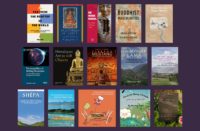
Published in Japan by Union Press in March 2019, “The Resurgence of ‘Buddhist Government’: Tibetan-Mongolian Relations in the Modern World” by Yumiko Ishihama, Makoto Tachibana, Ryosuke Kobayashi and Takehiko Inoue is a compilation of essays examining the interrelationships in the Tibetan Buddhist world encompassing Tibet, Mongolia, and Kalmykia.
From the Union Press website:
The book sheds a new light on how Tibet, Mongolia, and Kalmykia encountered the modern world during the late 19th to early 20th centuries.
The chapters focus on the perspectives of notable individuals such as the 13th Dalai Lama, and the 8th Jebtsundamba, in the Tibetan Buddhist world, rather than on great power relations between countries such as Britain, Russia and China. This volume, using valuable primary sources, contributes to a better appreciation of trans-regional personal and material exchanges among Tibetan Buddhists beyond national borders.
Contents
Introduction
Chapter 1: The emerging split between the Dalai Lama and the Jebtsundamba: A confrontation between the universal and the local church
Chapter 2: The exile and diplomacy of the 13th Dalai Lama (1904-1912): Tibet’s encounters with the United States and Japan
Chapter 3: Reigniting communication in the Tibetan Buddhist world: The Kalmyk pilgrimages in the late nineteenth and early twentieth centuries
Chapter 4: Parting with the Qing emperor and taking a new title
Chapter 5: The coronation of the Jebtsundamba modeled on the Dalai Lama’s enthronement
Chapter 6: The Lungshar delegation and Britain in 1913: Focusing on the letters of the 13th Dalai Lama
Chapter 7: A re-examination of the Mongol-Tibetan Treaty of 1913: Its contemporary significance
Chapter 8: Tibetans in Mongolia: Mongol-Tibetan relations in the early twentieth century
Chapter 9: Between Mongolia and Tibet: Qinghai (Kokenuur) Mongols in the early twentieth century
Available on Amazon here: https://amzn.to/2TtMW7g





Follow Us!